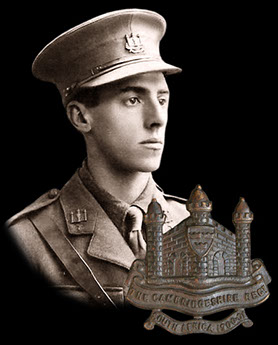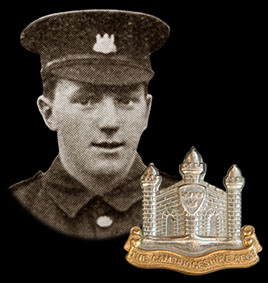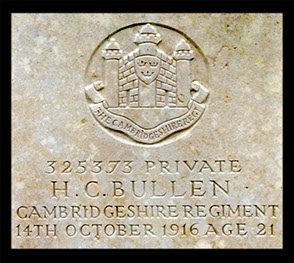
Who Were
The Cambs
The Cambs
at War
1/1st Btn 1914-1919
1914 - 1/1st Overview
1915 - 1/1st Overview
1915 - St Eloi
1915 - Fosse Wood
1916 - 1/1st Overview
1916 - The Schwaben
1916 - St Pierre Divion
1917 - 1/1st Overview
1917 - St Julien
Insignia, Medals & Books
Remembering The Cambs
Biographies
About Us &
This Site

The Cambridgeshires and the Schwaben Redoubt - October 14th & 15th 1916
Part 7 – Counter-Attacks and Relief
After the first wave of Cambridgeshires had jumped, bayonet first, into the trenches of the Schwaben Redoubt, everyone, from private to brigadier, was well aware that a German counter-attack was only a matter of time. Experts in the art of swift ad hoc attacks, often using specially trained troops, the Germans relied on this tactic as a key part of their defensive strategy. Every time the British made any advances in the Schwaben the German counter-attack either repelled them completely or took back large parts of the captured ground.
Since Riddell had first considered how to capture the north face of the Schwaben Redoubt, he had thought about the issue of German counter-attacks. He had taken numerous steps, discussed in part 2 of these articles, to insure that his men were well supplied and in the best possible situation to withstand any such attack. However he was well aware that all his precautions could easily unravel in the confusion of battle.
By late afternoon on the 14th October, much of the position was now in British hands. The problem area between the two attacking battalions was being cleared and fresh reinforcements were on their way to garrison it. Many of Riddell’s men were now busy constructing the strong points and fortified shell holes in the ground north of the Schwaben. The Redoubt was still coming under German artillery fire and there were multiple small-scale skirmishes, but the much anticipated counter-attack had still not materialised.
Unknown to Riddell and his men, the German troops were struggling to launch any form of organised push on the lost ground. Riddell’s carefully planned artillery bombardment was still causing chaos in the German positions and communication and troop movement were all but impossible. The attack group, including the specialist assault troops that would normally be at the spearhead of the counter-attack, was all but annihilated by artillery fire before they even reached the Redoubt.
By the time a further German attack was ready, the Cambridgeshires and their comrades had turned the captured position into a well-defended network of connected position. Throughout the night and early hours of the 15th, fighting flared in some locations, including the strong point on the far left where one German attack tried to push down the Strassburg line. The result of these small attacks was the same; they were all beaten back by the combined fire from the British positions.
Since his earlier foray into the Schwaben, Riddell had been busy at the Battalion HQ. The German shelling of the area had carried on until around midnight when it finally slackened. Taking the chance to escape from the dugout he emerged to find the body of the Battalion Intelligence Officer, Alfred Bradford, lying nearby. Writing in the regimental history he later wrote:
Fearless in life, he had done his work nobly. I am afraid I sobbed like a child; but I was not ashamed of this breakdown.
Taking full advantage of the pause in the German shelling, Riddell brought up some of his reserve officers and men from Paisley Dump. The cover of darkness and reduction in shelling meant more messages and details reached Battalion HQ from the men at the front. Around 1am Riddell, now with a clear picture of the situation, informed Finch-Hatton that his battalion would need to be relived owing to the high casualties among his officers and NCOs. The reply from the Divisional Staff was that relief would start from around 6am - it was going to be a long and tense wait for the men holding the Redoubt.
At around 4am German artillery fire on the Redoubt and the area around Battalion HQ suddenly began again. The heavy shelling was a warning sign of an attack and all across the captured position men waited for the first signs of enemy movement. Back at Battalion HQ the fresh wave of shelling finally scored a direct hit. The dugout was badly damaged and the blast left nearly all the occupants injured or knocked out. Riddell was left severely shell shocked and exhausted, his part in the fight had come to an end and he was eventually evacuated back to hospital.
Around the time that Battalion HQ was hit, the expected German attack pushed on the Schwaben from the north, focused around the trench near the Cambs’ right hand strong point. Initially there was a concern that it may be more of the Black Watch men who had overshot their objective moving back to their line. However as they came close they were identified as enemy soldiers and what’s more, they seemed totally oblivious of the Cambridgeshires' advanced positions. The brigade report dryly recorded the outcome:
… fire was held up until the enemy was quite close up when the enemy could be recognised. Machine gun and rifle fire was at once opened and the attack was practically exterminated.
The Battalion, now under the command of Captain Marr, had suffered very few casualties repelling the recent attack and the fighting, once again, died down. Riddell’s plan of strong points and an advanced improvised trench had been a huge success. Most of the German artillery fire had landed on the Schwaben and not on his new line of defence and the attacking Germans were caught by complete surprise. The biggest threat yet to the captured positions had been defeated with minimal casualties. With daylight now illuminating the battlefield, the risk of another German attack eased a little.
With the clear order that no men were to leave their position until they had been replaced by fresh troops, the relief of the Cambridgeshires took all day. The men in the forward line and in some of the strong points were unable to move safely in daylight, so they remained at their posts until the cover of night. Several groups of Cambridgeshires were still in the Redoubt when the next wave of German attacks was launched at around 9pm on the 15th. While these attacks were more organised than those of the previous night, even involving a flamethrower, they were all repulsed. Finally by around midnight, the last of the Cambridgeshires were relieved and made their way back to Wood Post where they rejoined their comrades. From there the Battalion then moved further back from the front to a tent camp at Senlis, west of Albert.
Early on October 16th, the remaining men of the 1/1st Battalion began the task of cleaning up, reorganising and rebuilding the bloodied battalion. Casualty lists showed that while losses had not been as high as some feared, the Cambs had certainly paid a high price for the captured ground. Losses for the Battalion on the 14th and 15th October numbered 55 men killed and around 178 wounded, 7 of which later succumbed to their wounds.
Messages of congratulations flooded in to Brigade HQ and special mention was made of the Cambridgeshires’ gallant action, Sir Douglas Haig even sending a gift of cigarettes for the men (although Riddell later noted that it was a “consignment of fruit”). Alongside the various reports and casualty lists, the recommendations for gallantry decorations and medals were written up and submitted. In total the men of the 1/1st Battalion earned an impressive thirty-one awards: one DSO, three MCs, five DCMs and twenty-two MMs for the capture and defence of the Schwaben Redoubt.
Riddell was suffering from shell shock and exhaustion, he was ordered back to England for a rest. Command of the Battalion was temporarily given to the second in command of the 4/5th Black Watch, Major Thomas Murray. He was a popular choice and was described by one Cambs officer as:
… very ugly, very Scotch, but very nice and has a most humorous outlook on life – a very good fellow.
News of the Cambridgeshires’ success soon reached home through a flood of letters to family and friends. Alongside the buoyant letters came the grim news of the casualties. Owing to the ferocity of the fighting, the heavy shelling and the terrible ground conditions, over half of the fallen were not found and were reported as missing. For their families the harrowing and soul crushing wait for news of their loved ones would go on.
After the armistice the gruesome task of searching the old battlefields, including the Schwaben Redoubt, for the bodies of the fallen was undertaken. The Schwaben and surrounding area was dotted with dozens of small cemeteries. These cemeteries contained some of the men that had been found soon after the fighting. Other bodies were found in single or group field graves, sometimes marked with a cross. One of the missing Cambridgeshires who was found by the Grave Registration Unit was Harry Bullen from Cambridge. He had been listed as missing since the fighting. His body was found in a field grave just beside the Schwaben and close to where he was killed while fighting with D Coy. But many other bodies had simply been lost in the countless shell holes and sadly were usually found by the GRU with no means of identification. Many of the missing have never been found and still remain where they fell.
During the grave concentration work, any bodies that were found, whether identified or unknown, were moved to larger cemeteries. The Cambridgeshires with known graves who fell during the fighting at the Schwaben on the 14th and 15th October 1916 are now buried in some of the nearby CWGC cemeteries. They are: Mill Road Cemetery, Connaught Cemetery, Contay New British Cemetery, Serre Road Cemetery No.2, Dantziq Alley Cemetery, Gommecourt Cemetery and Lonsdale Cemetery. The fallen Cambridgeshires who still have no known grave could well be buried in any of these cemeteries under an unknown soldier's gravestone. Their names are recorded on the nearby Thiepval memorial alongside over 72,000 other missing soldiers from the Somme battlefields.
Back to the top of the page.
A view across part of the Schwaben Redoubt shortly after it was captured.
The Cambridgeshires & the Schwaben Redoubt
Part 1 - Background & History of the Redoubt
Part 2 - Riddell's Plan
Part 3 - Misfortune & Postponement
Part 4 - The Assault
Part 5 - Strong Points & Riddell Trench
Part 6 - Gallant Deeds
Part 7 - Counter-Attacks and Relief

Lt Alfred Bradford, killed in action.

Charles Brittain, one of the missing now listed on the Thiepval Memorial.

George Nightingale, one of the twenty-two Cambridgeshires awarded the MM.

Inscription on Harry Bullen's grave, he is now buried in Mill Road Cemetery.

This site went live on the 14th February 2015 to mark 100 years since the 1/1st Cambs went off to war.
WE WILL REMEMBER THEM
Email us: cambsregt@gmail.com
Copyright 2015, 2016, 2017, 2018, 2019 by Felix Jackson. The information and images on this site should not be reproduced without prior permission.